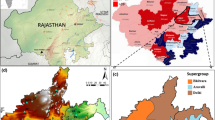Abstract
Consumption of unusually high concentrations of F− in groundwaters of the Maria area in the Gaspé peninsula of Quebec have resulted in symptoms of skeletal fluorosis in two members of the population. One of these individuals consumed approximately 50 mg of fluoride per day over a 6 year period before being hospitalized and later diagnosed with skeletal fluorosis. It is estimated that, until this case came to light, approximately 15–20% of the rural population (total approximately 1,600) in the area were consuming groundwaters with F− levels between 5 and 28 mg L−1 for at least 6 years. The high concentrations of F− in well waters of the Maria area occur only in wells completed in Carboniferous sandstone-siltstone-conglomerate sediments that underlie a thick blanket of alluvial-colluvial-glacial overburden. These fluoriferous groundwaters exhibit high Na and HCO3 − contents and low Ca and Mg concentrations compared to those associated with the overburden sediments. The high F levels greatly increase the risk for fluorotic diseases such as skeletal fluorosis and skeletal radiculomyopathy. Wells completed in overburden, although having suboptimal F− levels are safer for the health of individuals in this region. Effective regulations for well drilling need to be formulated for regions underlain by Carboniferous formations in the Maritime provinces of Canada. In some regions, high F− levels (10–25 mg L−1) in groundwaters will seriously affect how, and to what extent, groundwater supplies can be developed for domestic use.
Similar content being viewed by others
References
Bond, D.W. 1946. A geochemical survey of the underground water supplies of the Union of South Africa. Union of South Africa Dept. of Mines, Geological Survey Mem., 14, 208p.
Boyle, D.R. 1992. Effects of base exchange softening on fluoride uptake in groundwaters of the Moncton Sub-Basin, New Brunswick,* Canada. In: Kharaka, Y.K. and Maest, A.S. (eds), Water-Rock Interaction, Proc. 7th Int. Symp. on Water-Rock Interaction, pp. 771–774. A.A. Balkema, Rotterdam.
Canadian Public Health Association. 1979. Criteria document in support of a drinking water standard for fluoride. Canadian Public Health Assoc. Publ., Ottawa, Canada, 118p.
Cederstrom, D. J., 1946. Genesis of groundwaters in the coastal plain of Virginia. Economic Geology, 41 (3), 218–245.
Clark, A., 1942. Further notes on the effects of inhibitory substances in foods. Article 7. J. Tropical Medicine and Hygiene, 45 (7), 49–51.
Foster, M. D., 1950. The origin of high sodium bicarbonate waters in the Atlantic and Gulf Coastal Plains. Geochimica Cosmochimica Acta, 1 (1), 32–48.
Goldman, S.M., Sievers, M.L. and Templin, D.W. 1971. Radiculomyopathy in a southwestern Indian due to skeletal fluorosis. Arizona Medicine, 28 (9), 675–677.
Hamamoto, E. 1957. On bone changes observed in residents of a high fluorine zone. In: Utzino, S. (ed.), Medico-Dental Researches on Fluorides pp. 118–130. Japan Soc. for Promotion of Science, Tokyo.
Indian Academy of Geoscience. 1977. Proceedings of the Symposium on Fluorosis. Indian Academy of Geoscience Publ., Hyderabad, India, 534p.
Kilborn, L.G., Outerbridge, T.S. and Lei, H.P., 1950. Fluorosis with a report of an advanced case. Canadian Medical Association Journal, 62, 135–141.
Leone, N.C., Stevenson, C.A., Hilbish, T.F. and Sosman, M.C. 1955. Roentgenologic study of human population exposed to high-fluoride domestic water: ten-year review. Am. J. Roentgenol., Rad. Therapy and Nuclear Med., 74, 874–885.
Lyth, O. 1946. Endemic fluorosis in Kweichow, China. Lancet, 1, p233.
Moller, P.F. and Gudjonsson, S.V. 1932. Massive fluorosis of bones and ligaments. Acta Radiol., 13, 269–304.
Morris, J.W. 1965. Skeletal fluorosis among Indians of the American southwest. Am. J. Roentgenol., Rad. Therapy and Nuclear Med., 94 (3), 608–615.
Nanyaro, J.T., Aswathanarayana, U., Mungure, J.S. and Lahermo, P. 1984. A geochemical model for the abnormal fluoride concentrations in waters in parts of northern Tanzania. J. Afr. Earth Sci., 2 (2), 129–140.
National Academy of Sciences. 1970. Fluorides: Biological effects of atmospheric pollutants. National Academy of Sciences Publ., Washington, D.C., 295p.
Ockerse, T. 1946. Endemic fluorosis in South Africa. Union South Africa Government Printer, Pretoria, 114pp.
Odenthal, H. and Wieneke, H.L., 1959. Chronische fluorvergiftung und osteomyelosklerose. Deutsche Medizinische Wochenschrift, 84 (15), 725–728.
Shortt, H.E., McRobert, G.R., Barnard, T.W. and Nayar, A.S.M. 1937. Endemic fluorosis in the Madras presidency. Ind. J. Med. Res., 25, p553.
Teotia, S.P.S. and Teotia, M. 1988. Endemic skeletal fluorosis: clinical and radiological variants. Fluoride, 21 (1), 39–44.
World Health Organization. 1970. Fluorides and human health. World Health Organization Publ., Monograph Series No. 59, Geneva, Switzerland, 364p.
World Health Organization. 1984. Fluorine and fluorides: Environmental health criteria 36. World Health Organization Publ., Geneva, Switzerland, 136p.
Zack, A.L. 1980. Geochemistry of fluoride in the Black Creek aquifer system of Horry and Georgetown counties, South Carolina — and its physiological implications. U. S. Geol. Survey Water Supply Pap. 2067, 40p.
Zaitlin, B.A. and Rust, B.R. 1983. A spectrum of alluvial deposits in the Lower Carboniferous Bonaventure Formation of western Chaleur Bay area, Gaspé and New Brunswick, Canada. Can. J. Earth Sci., 20, 1098–1110.
Zipkin, I., McClure, F.J., Leone, N.C. and Lee, W.A. 1958. Fluoride deposition in human bones after prolonged ingestion of fluoride in drinking water. Public Health Report, 73, 732–740.
Author information
Authors and Affiliations
Additional information
To whom correspondence should be addressed.
Rights and permissions
About this article
Cite this article
Boyle, D.R., Chagnon, M. An incidence of skeletal fluorosis associated with groundwaters of the maritime carboniferous basin, Gaspé region, Quebec, Canada. Environ Geochem Health 17, 5–12 (1995). https://doi.org/10.1007/BF00188625
Revised:
Accepted:
Issue Date:
DOI: https://doi.org/10.1007/BF00188625




